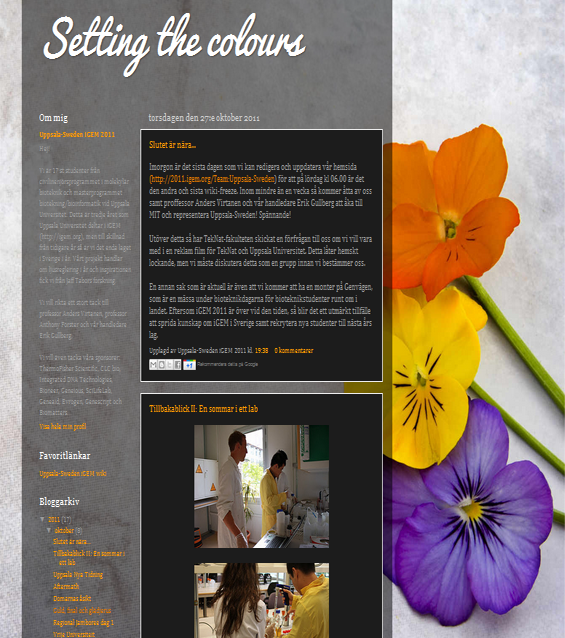Team:Uppsala-Sweden/Project
From 2011.igem.org
(→Overall project) |
|||
| (132 intermediate revisions not shown) | |||
| Line 1: | Line 1: | ||
| - | + | {{Template:Uppsala-SwedenTemplate}} | |
| + | {{Template:Uppsala-SwedenTemplateSidebar}} | ||
| + | <div class="wrap_12"> | ||
| + | <div id="maincontent"> | ||
| + | <span class="blue"></span> | ||
| + | </div> | ||
| + | |||
| + | <div id="menu" class="hp clearfix main"> | ||
<html> | <html> | ||
| - | < | + | <script type="text/javascript">var MenuLinkedBy="AllWebMenus [4]",awmMenuName="unicodemenus",awmBN="846";awmAltUrl="";</script><script charset="UTF-8" src="http://aminsaffari.com/JS/unicodemenus.js" type="text/javascript"></script><script type="text/javascript">awmBuildMenu();</script> |
| - | + | </html> | |
| - | + | ||
</div> | </div> | ||
| - | |||
| - | |||
| - | |||
| - | |||
| - | |||
| - | |||
| - | |||
| - | |||
| - | |||
| - | + | <!--</div>--> | |
| - | + | ||
| - | + | ||
| - | + | ||
| - | + | ||
| - | + | ||
| - | + | ||
| - | + | ||
| - | + | ||
| - | + | ||
| - | + | ||
| - | < | + | <div class="prefix_4 grid_11 suffix_1 maincontent" id="Uppsalacontent"> |
| - | + | ||
| - | + | ||
| - | + | ||
| - | + | ||
| - | + | ||
| - | + | ||
| - | + | ||
| - | + | ||
| - | + | ||
| - | + | ||
| - | + | ||
| - | + | ||
| - | + | ||
| - | + | ||
| - | + | ||
| - | + | ||
| - | + | ||
| - | + | ||
| - | + | ||
| - | + | ||
| - | + | ||
| - | + | ||
| - | + | ||
| - | + | ||
| - | + | ||
| - | + | ||
| - | + | ||
| - | + | ||
| - | + | ||
| - | + | ||
| - | + | ||
| - | + | ||
| - | + | ||
| - | + | ||
| - | + | ||
| - | + | ||
| - | + | ||
| - | + | ||
| + | <br> | ||
| + | <div class="grid_Blue_thin omega mywhite"> | ||
| + | Project overview | ||
| + | </div> | ||
| + | Regulation of gene expression by light is a milestone in synthetic biology. As a contribution of UT Austin in iGEM 2004, the concept of [http://partsregistry.org/Coliroid "coliroids"] was coined and thereby widely recognized. Light regulation introduces noninvasive, direct and advanced spatio-temporal control of engineered biological systems. | ||
| - | + | Ever since iGEM 2004, as more and more naturally occurring light-sensing microorganisms are being discovered and sequenced, synthetic biologists realize there is a whole range of natural light-sensing systems at their disposal. Other than using natural light-sensing proteins, engineered proteins have been designed from the natural templates. However, most of the light-sensing systems developed thus far focus on studying one light-sensing system at a time, characterizing the activation light spectra, active state, etc. Nobody has ever built systems capable of detecting multiple wavelengths until recently. In short, our project focuses on improving the existing multichromatic sensing systems by expanding the number of useful wavelengths. Our system can regulate the expression of three different genes independently from each other using three different wavelengths. These "multichromatic coliroids" upgrades the present coliroids, much like upgrading black-and-white movies to color TV. The proof of concept will be demonstrated by growing a colorful picture on bacteria culture, much like Andy Ellington's [http://partsregistry.org/Image:EllingtonColiroid.png coliroids picture] but with color. | |
| + | {{Template:Uppsala-SwedenTemplatefooter}} | ||
Latest revision as of 02:23, 22 September 2011
Project overview
Regulation of gene expression by light is a milestone in synthetic biology. As a contribution of UT Austin in iGEM 2004, the concept of [http://partsregistry.org/Coliroid "coliroids"] was coined and thereby widely recognized. Light regulation introduces noninvasive, direct and advanced spatio-temporal control of engineered biological systems.
Ever since iGEM 2004, as more and more naturally occurring light-sensing microorganisms are being discovered and sequenced, synthetic biologists realize there is a whole range of natural light-sensing systems at their disposal. Other than using natural light-sensing proteins, engineered proteins have been designed from the natural templates. However, most of the light-sensing systems developed thus far focus on studying one light-sensing system at a time, characterizing the activation light spectra, active state, etc. Nobody has ever built systems capable of detecting multiple wavelengths until recently. In short, our project focuses on improving the existing multichromatic sensing systems by expanding the number of useful wavelengths. Our system can regulate the expression of three different genes independently from each other using three different wavelengths. These "multichromatic coliroids" upgrades the present coliroids, much like upgrading black-and-white movies to color TV. The proof of concept will be demonstrated by growing a colorful picture on bacteria culture, much like Andy Ellington's [http://partsregistry.org/Image:EllingtonColiroid.png coliroids picture] but with color.
 "
"

















